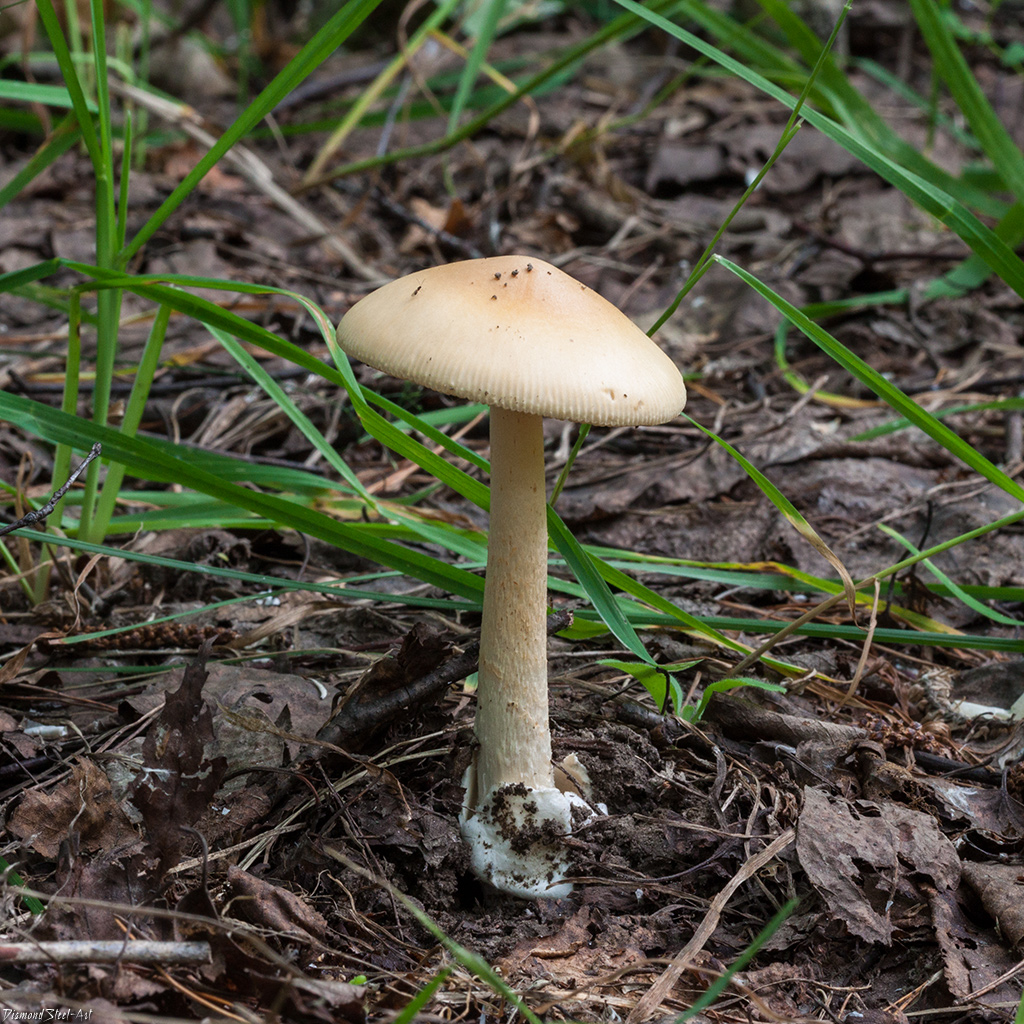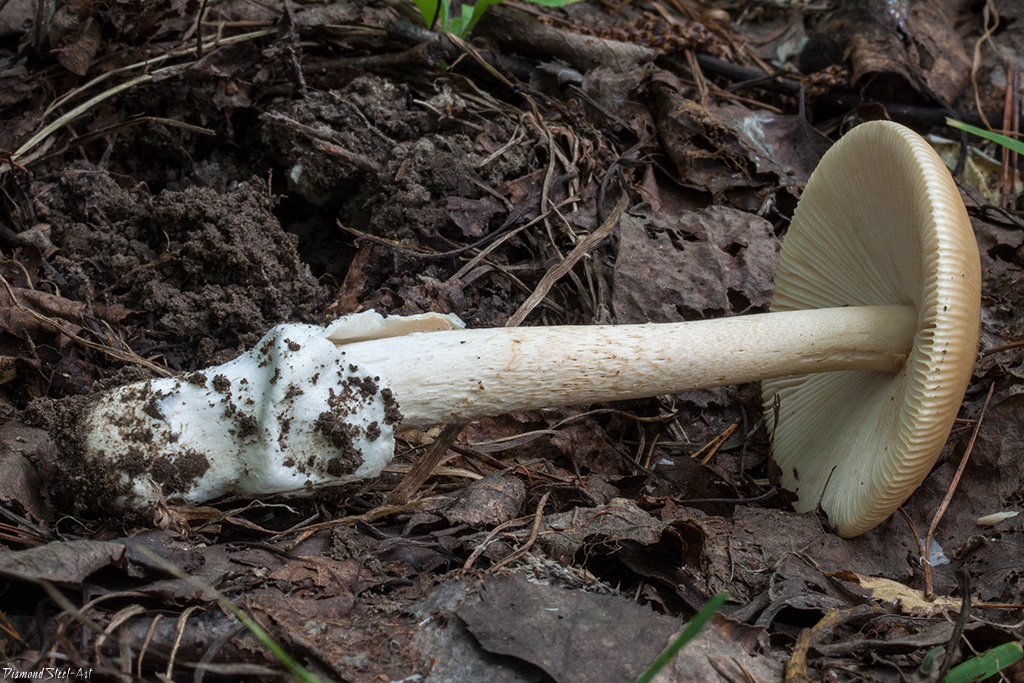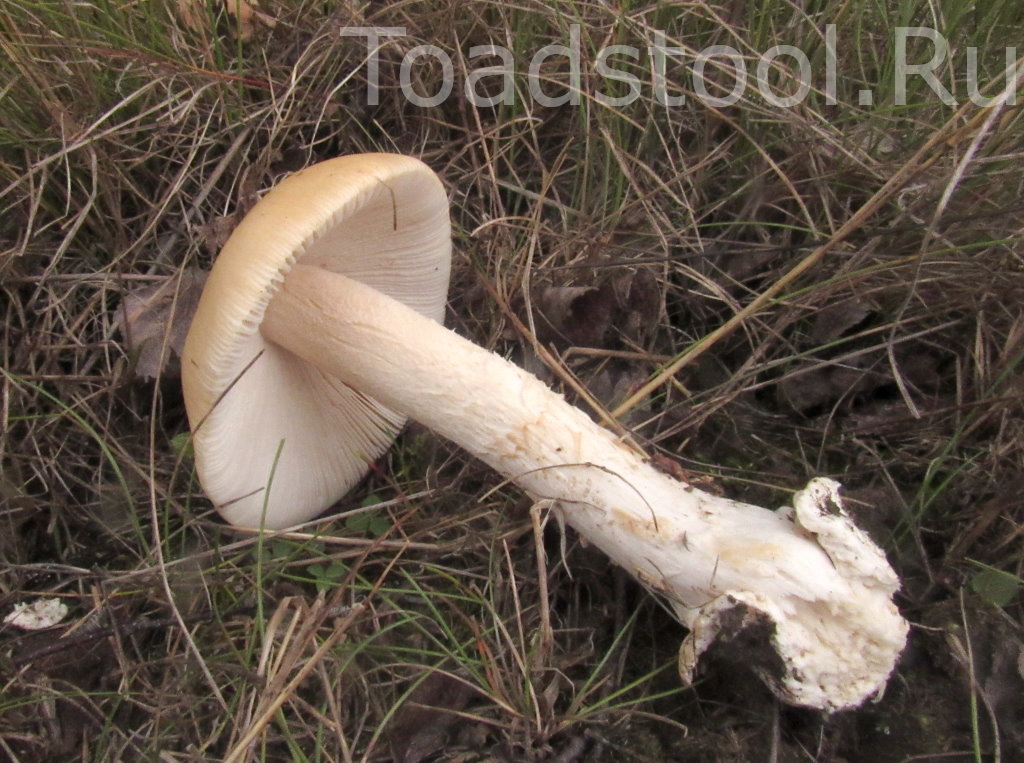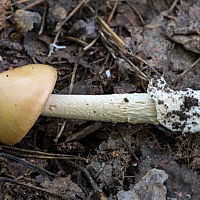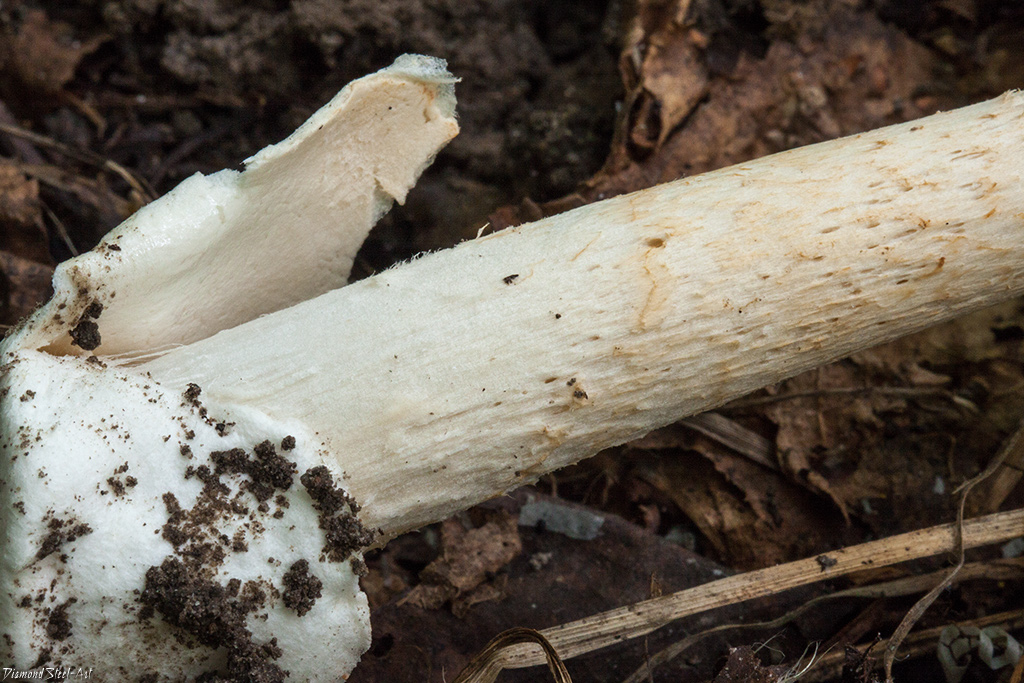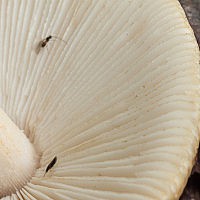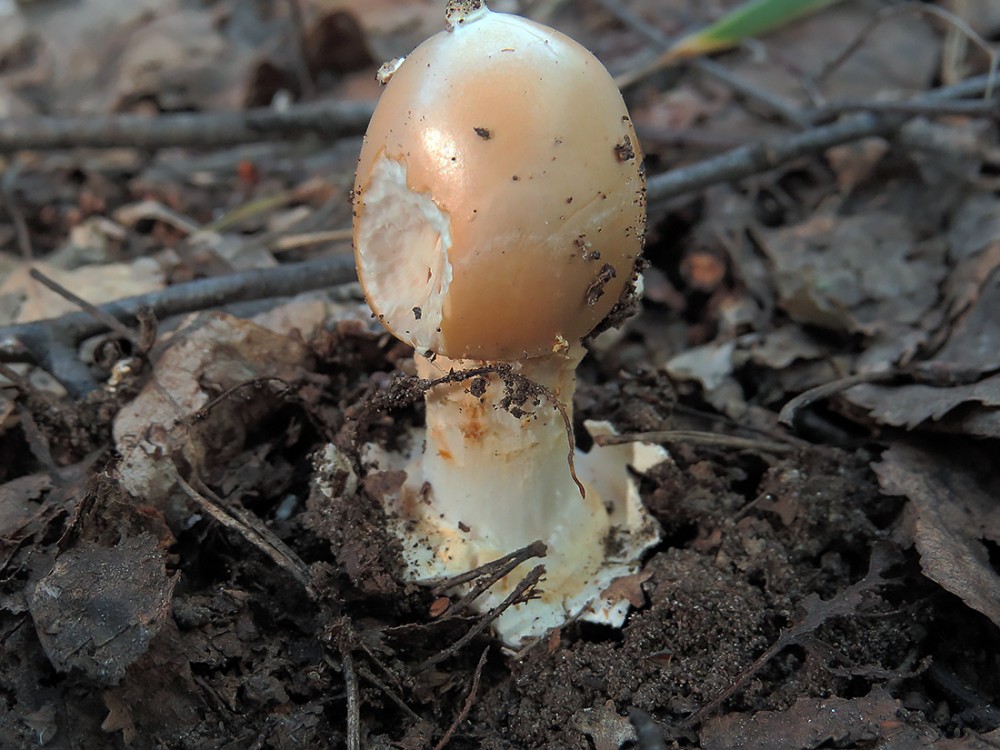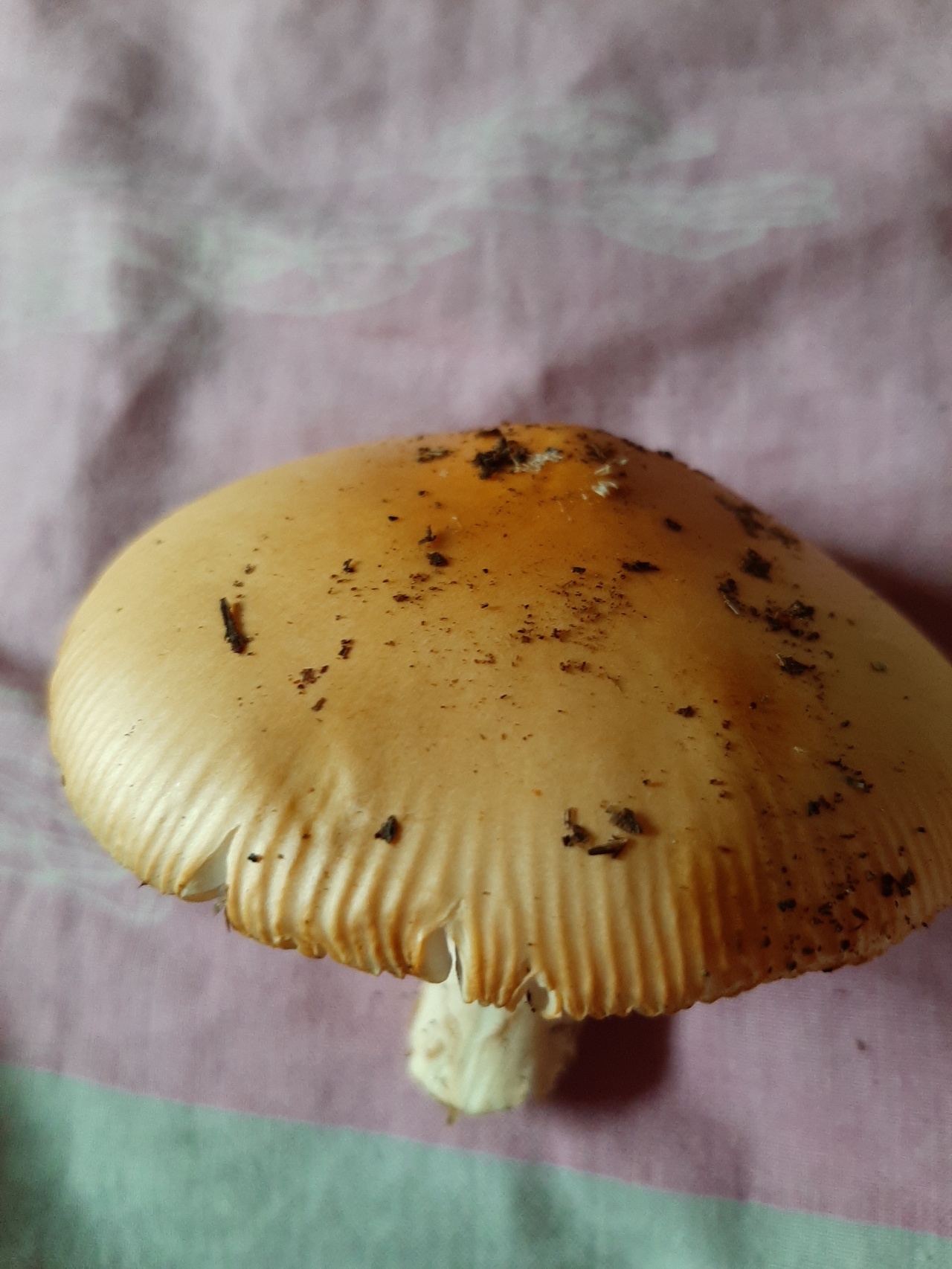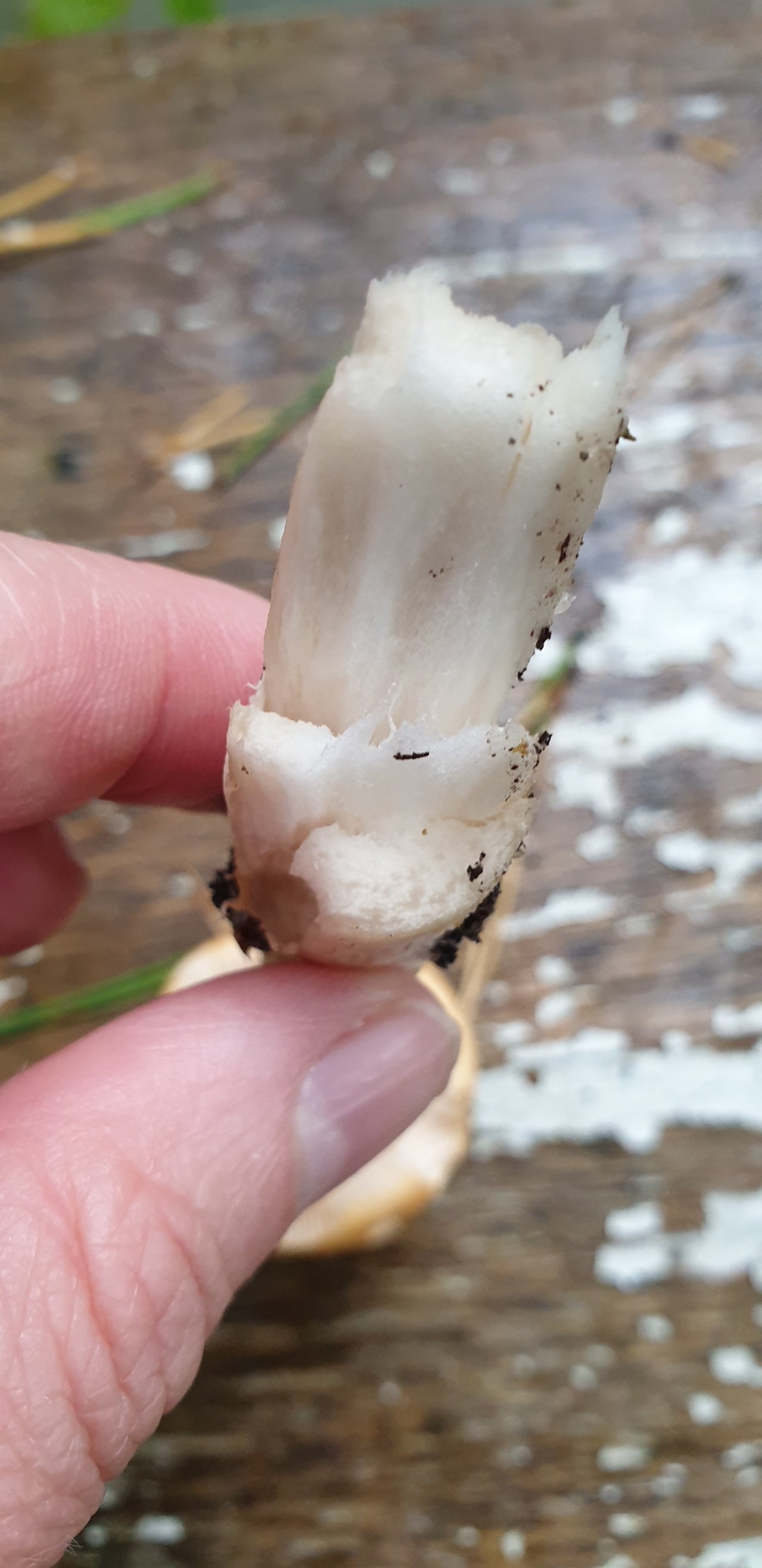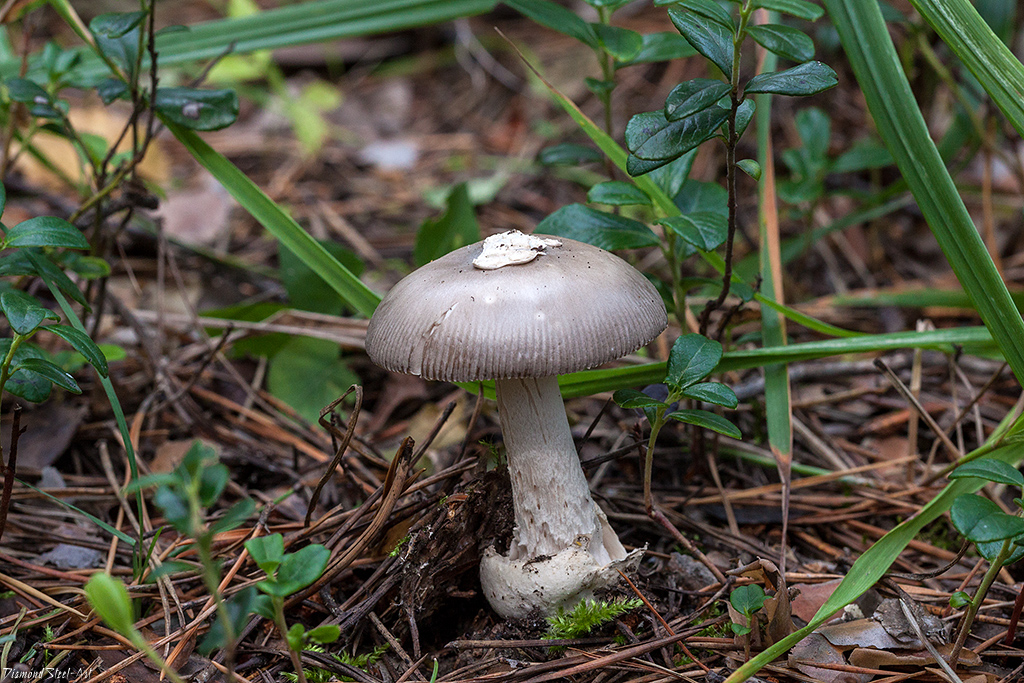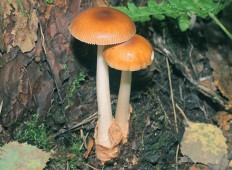Yellowing float (Amanita flavescens)
Synonyms:
- Amanitopsis vaginata var. flavescens
- Amanita vaginata var. flavescens
- Amanita contui
- False Saffron Ringless Amanita
- False float saffron

Like all Amish, the yellowing float is born from an "egg", a kind of common blanket, which breaks during the growth of the fungus and remains at the base of the leg in the form of a "pouch", a volva.
In English-speaking countries there is a name "False Saffron Ringless Amanita" - "False saffron fly agaric", "False saffron float". Apparently, this is due to the fact that the saffron float is found much more often than yellowing, and is better known.
Description
Cap: ovoid in youth, then expands to bell-shaped, convex, outstretched, often retaining a tubercle in the center. The surface of the cap is radially grooved by 20-70%, the grooves are more pronounced towards the edge of the cap - the plates are visible through the thin pulp. Dry, matte. Remnants of the common bedspread may be present (but not always) in the form of small whitish specks. The skin color of the cap in young specimens is light, pale yellow; with age, the skin becomes light yellow or orange-cream, creamy-pinkish, between beige and orange-cream. Wounds tend to be yellowish.
The flesh of the cap is very thin, especially towards the edge, fragile.
Plates: loose, frequent, wide, with numerous plates of different lengths. White to pale orange-cream, irregularly colored, darker towards the edge.
Stem: 75–120 x 9–13 mm, white, cylindrical or slightly tapering upwards. Whitish, with an indistinct velvety pattern in the form of belts and zigzags, creamy, light straw-yellow or pale ocher color.
Ring: missing.
Volvo: loose (attached only to the base of the leg), baggy, white. Irregularly torn, has from two to four petals, sometimes of very different heights, Outside is white, clean, without rusty spots. The inner side is light, almost white, whitish, with a yellowish tinge.

Spore powder: white Spores: (8.4-) 89.0-12.6 (-17.6) x (7.4-) 8.0-10.6 (-14.1) microns, globose or subglobose, broadly ellipsoid (infrequently), ellipsoid, non-amyloid.
Basidia without clamps at the bases.
Taste and smell: no special taste or smell.
Season and distribution
The yellowing float bears fruit abundantly from June to October (November with a warm autumn). It is widespread both in Europe and Asia, in countries with temperate and cool climates.
Edibility
The mushroom is edible after boiling, like all floats. Reviews are very different about taste, but taste is a very individual matter.
Saffron float (Amanita crocea)
It has a well-defined, distinct moire pattern on the stem of a darker, "saffron" color. The hat is more brightly colored, although this is an unreliable macro sign, given the possible fading. A more reliable distinguishing feature is the color of the inner side of the Volvo, for the saffron float it is dark, saffron.
Float yellow-brown (Amanita fulva)
It has a darker, more saturated, orange-brown cap, and this is also an unreliable sign. The outer side of the Volvo at the yellow-brown float is covered with fairly well-distinguishable "rusty" spots. This sign is considered more reliable, so do not be lazy to carefully dig up the Volvo and examine it.
There is a lot of information in the Russian-speaking sector that causes, to put it mildly, bewilderment. So, for example, for the author of this note, the question of ecology remained open. A number of authoritative sources indicate "mycorrhiza with birch" and period. The Belarusian site talks about "mycorrhiza with deciduous and coniferous trees." soils.
Separately, it should be said about edibility. Pre-boiling is recommended. There is information that the yellowing float is poisonous in its raw state (no links to confirmation of information about the toxicity could be found).
The article uses photos from the questions in recognition, authors: Ilya, Marina, Sanya.
Season and habitat of the mushroom
The snow-white float is found on soils in wooded areas, at the edges of forests. They are among the active mycorrhiza formers. You can meet this type of mushroom on all continents except Antarctica. Most often, this mushroom can be found in deciduous forests, but sometimes it grows in mixed forests. In the mountains, it can grow at altitudes of no more than 1200 m. You can rarely meet a snow-white float here, little-known and poorly studied by scientists. Active fruiting of this species of mushrooms lasts from July to October. Found in Ukraine, Russia, in some European countries (England, Switzerland, Germany, Sweden, France, Latvia, Belarus, Estonia). In addition, the snow-white float also grows in Asia, in the Altai Territory, China and Kazakhstan. In North America, the fungus of this species grows in Greenland.
External description
Mushroom Snow-white float (Amanita nivalis) is a fruiting body, consisting of a cap and a leg. The cap of this mushroom reaches 3-7 cm in diameter, in young and immature mushrooms it is characterized by a bell-shaped shape, gradually becoming convex-prostrate or simply convex. In the middle of the cap, a bulge is clearly visible - a tubercle. In its central part, the cap of the snow-white float is rather fleshy, but at the edges it is uneven, ribbed. The skin of the cap is mostly white, but has a light ocher tint in the center.
The leg of the snow-white float is 7-10 cm long and 1-1.5 cm in diameter. Its shape is cylindrical, slightly expanding near the base. In immature mushrooms, the leg is quite dense, but as it matures, cavities and voids appear inside it. The leg of young snow-white floats is characterized by a white color, gradually darkens, becoming dirty gray.
The mushroom pulp has no pronounced aroma or taste. In case of mechanical damage, the pulp of the fruiting body of the fungus does not change its color, remaining white.
On the surface of the fruiting body of the snow-white float, the remains of the bedspread are visible, represented by a bag-shaped and wide enough volvo of white color. There is no ring, characteristic of many types of mushrooms, near the stem. On the cap of young mushrooms, you can often see whitish flakes, but they disappear without a trace in ripening mushrooms.
The hymenophore of the snow-white float (Amanita nivalis) is characterized by a lamellar type. Its elements - plates, are located often, freely, and significantly expand towards the edges of the cap. Near the foot of the plate are very narrow, but in general they can have different sizes.
The spore powder is white in color, and the microscopic pore sizes vary within 8-13 microns. They are round in shape, smooth to the touch, contain fluorescent drops in the amount of 1 or 2 pieces. The skin of a mushroom cap consists of microcells, the width of which does not exceed 3 microns, and the length is 25 microns.
Description of the Sicilian fly agaric
The cap of the Sicilian fly agaric is large - its diameter is 10-15 centimeters. Young Sicilian fly agarics have ovoid caps; over time, they become convexly outstretched. The color of the cap varies from yellow-brown to dark brown. The hat is darker towards the center and lighter towards the edges. The edges are striped, and in older specimens they become furrowed. Young mushrooms are covered with thick ash-gray volva, over time the volva disintegrates, and large warts remain from it, and even later the warts are destroyed.
The leg is very long - its height ranges from 12 to 25 centimeters, and its diameter can be 1.5-3 centimeters. The color of the leg is initially yellow-brown or light pink, and over time it becomes light gray. The coloring of the leg is zonal.At the base of the leg, remains of an ash-gray Volvo remain. When pressed, the remains of the Volvo darken. The plates of the Sicilian amanita are light.
Spreading places of strange floats
These mushrooms grow in deciduous and deciduous forests, as well as in parks. They live on clayey heavy soils. Weird floats are rare.
Amanita muscariae are common in central Europe. They are also found in Ukraine, Eastern Siberia, Transcaucasia, the Far East, South America and North America.
There is no information about the edibility of Sicilian fly agarics, they are not eaten and are considered an inedible species.
Related species
Amanita muscaria is an edible representative of the Amanita family. The cap of this mushroom at a young age is convex, up to 10 centimeters in diameter, yellow-brown in color. With age, the color of the cap becomes darker - dirty brown. The surface of the cap is glossy with small granular scales. The leg can reach a height of 15 centimeters. Its color is the same as the hat. There is a clearly visible white ring at the top of the stem.
Amanita muscariae are quite common mushrooms. This is the most unpretentious species that can grow on any soil. These mushrooms can settle in any forests. Amanita muscaria bears fruit from summer to late autumn. They are good edible mushrooms that can be fried, pickled, and frozen.
But they should be collected with care so as not to be confused with dangerous types of fly agaric.
Amanita Vittadini is a conditionally edible mushroom. His hat is white, brown or sometimes greenish, its diameter is 4-14 centimeters. On the cap there are densely scaly remnants of the bedspread, which rise above its surface. The leg is white with a smooth ring on it.
Amanita muscaria Vittadini grows in the southern regions of Russia, they are also common in Europe. These mushrooms grow in warm climates. They bear fruit from spring to autumn. Young specimens are edible, smell and taste good.
Float yellow-brown (amanita orange, yellow-brown): photo and description
| Name: | Float yellow-brown |
| Latin name: | Amanita fulva |
| Type of: | Conditionally edible |
| Synonyms: | Amanita orange, Amanita yellow-brown, Brown float, Orange float |
| Specifications: |
|
| Systematics: |
|
The yellow-brown float is a rather unremarkable representative of the mushroom kingdom, very common. But its belonging to the family Amanitaceae (Amanitovye), genus Amanita (Amanita), raises a number of doubts about edibility. In Latin, the name of this species sounds Amanita fulva, and the people call it orange, yellow-brown fly agaric or brown float.

What a yellow-brown float looks like
A fairly common and widespread yellow-brown float is considered safe for humans, but due to its belonging to the Amanita genus, even experienced mushroom pickers are somewhat wary of this mushroom.
The float itself has a fruiting body of a well-formed cap and leg (agaricoid), a hymenophore is lamellar.

Description of the hat
A young amanita mushroom yellow-brown has an egg-shaped cap with curled edges, which, with its growth, straightens out and becomes flat in diameter from 4 to 10 cm with an inconspicuous tubercle in the center. The color is uneven, orange-brown, darker in the middle up to a brown shade. The surface is smooth, slightly mucous, grooves are clearly visible along the edge.
The pulp is rather fragile, watery, more fleshy in the center of the cap. On the cut, its color is white, the smell is slightly mushroom, the taste is sweetish.
Hymenophore with plates often located not adherent to the pedicle. The color is white with a yellowish or creamy tinge. The spore powder is beige, the spores themselves are spherical.

Leg description
The leg is regular, cylindrical, rather high - up to 15 cm. Diameter - 0.6-2 cm. Rings, like a typical fly agaric, have no rings. But there is a bag-like free Volvo, on which you can see yellow-brown spots.
The surface of the leg is solid white with an orange tint, smooth, sometimes with small felt scales. Inside, it is hollow, the structure is dense, but rather fragile.

Where and how it grows
The yellow-brown float grows everywhere practically throughout the continent of Eurasia - from the countries of Western Europe to the Far East. It can also be found in North America and even in northern Africa. In Russia, it is considered a common and fairly common species, especially in Western Siberia, Primorsky Territory, Sakhalin and Kamchatka.
It grows more in coniferous and mixed forests, less often in deciduous ones. Prefers acidic soils and wetlands.
The fruiting period is long - from early summer to mid-autumn (June-October). Fruit bodies grow both singly and in small groups.
Is the mushroom edible or not
The yellow-brown float is classified as conditionally edible, while it has a weakly expressed, but pleasant taste. Due to the fragility of the pulp, this mushroom is not very popular with mushroom pickers, since in general it is almost impossible to bring the fruit bodies home.
Doubles and their differences
Among similar species with a yellow-brown float, the following can be distinguished:
- the yellowing float, also conditionally edible, is distinguished by a lighter pale yellow color and the absence of spots on the Volvo;
- the float is umber yellow, it is also considered conditionally edible, it is distinguished by the color of the cap without brown tones, as well as a light shade of the edges.
It is also worth noting that outwardly, almost all floats are similar, and they belong to a number of conditionally edible ones. But specifically, the brown float can be distinguished from many representatives of poisonous fly agarics by the absence of a ring on the leg.
Conclusion
The yellow-brown float is a close relative of poisonous fly agarics, but unlike them, this species is still considered conditionally edible and safe for consumption after prolonged boiling. The taste is poorly expressed, therefore, fruit bodies still do not represent any special gastronomic value. Also, mushroom pickers are not of interest due to fragility.
How to cook mushroom floats?
There are connoisseurs and amateurs who praise the taste and consistency of saffron floats, prepared without pre-processing (boiling). However, given that the collection of these mushrooms is risky in itself, their fruiting bodies must be boiled - preferably in two waters, each time completely draining the broth. Then the fruit bodies processed in this way are fried, soups are boiled, and stewed. Their preparation is immediately undertaken immediately after collection - these mushrooms are not subject to even short-term storage.
Saffron floats, they are also pushers, are strict examiners for fans and connoisseurs of mushroom dishes. Their dangerous resemblance to the bright yellow fly agaric can be fatal. Therefore, some experts do not recommend picking these mushrooms at all, despite the conditional edibility and good taste.
Based on the book by M. Vishnevsky “Medicinal mushrooms. Great Encyclopedia "
Float yellow-brown - Amanita fulva
Written by Nikolay Budnik and Elena Meck.
The yellow-brown float is quite common on the Zheleznaya Ulom. The mushroom grows in July - August on the outskirts of bogs, among mosses, singly and in small groups.
The yellow-brown float is an edible mushroom, but we do not collect it because of its strong fragility and fragility. It is difficult to bring him home safe and sound, even in a basket.

1. A yellow-brown float grows in damp places.

2. This is probably why it can be seen in the hottest time.

3.. when other mushrooms hardly grow.

4. We have it in July.

5. Sometimes individual mushrooms can be found as early as mid-June.

6.We saw the last floats in the middle of September.

7. The fungus usually grows either alone.

eight. . or in small groups.

9. This is a very delicate and fragile mushroom.

10. We tried to collect it several times.

eleven. . but it was never possible to bring them to the house intact.

12. Some amateurs say that this mushroom is very tasty when cooked.

13. It will be necessary to try it.

14. The yellow-brown float likes damp places.

15. It can also be found in the forest.

16 . and at the edge of a pine bog.

17.. and in the swamp itself.

18. The mushroom grows in the mixed forest.

19. This is a typical place where you can find a yellow-brown float

20. The mushroom has a small cap and a long thin stem.

21. Here is the size of young and mature floats.

22. And this is the diameter of the cap of a mature mushroom. It doesn't grow anymore.

23. The hat is exactly yellow-brown, slightly darker in the middle.

24. She is very thin and fragile.

25. Only in very young mushrooms does it look like a cap.

26. Soon the hat straightens out.

27. Strong ribbing, ribbing of the edge is a characteristic feature of the float.

28. This is how the cap joins the leg.

29. The plates of the mushroom are initially white, of medium frequency.

30. Brown spots appear on them with age.

31. The plates turn slightly yellow, become brittle and sloppy.

32. So they join the leg.

33. The leg of the yellow-brown float is thin and long.

34. It is much longer than the diameter of the cap in length.

35. At the very bottom, the leg thickens tuberously.

36. It grows from a saccular volva of the same color as the leg.

37. Let's take a closer look at the attachment of the leg to the ground.

38. The leg is hollow inside.

39. It is so fragile that it is very difficult to cut it lengthwise.

40. Still, you can see the cavity inside the leg.

41. Another characteristic feature of the float is that there is NO RING on the leg.

42. The absence of a ring distinguishes floats from fly agaric.

43. The flesh of a yellow-brown float is tender, fragile, brittle.

44. We hope that we will try this mushroom anyway.
A small video filmed in the forests of Uloma Zheleznaya





